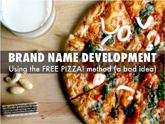News
You Should Always Check International Communication of Your Name, or Risk This!
The photo below pretty much says it all.
 Assitalia is one of the biggest insurance companies in Italy. I am sure the company developed its name without thinking about international considerations. In Italy, the name is probably fine. But if they ever wanted to expand to an English speaking country…well, let’s just say there might be a problem.
Assitalia is one of the biggest insurance companies in Italy. I am sure the company developed its name without thinking about international considerations. In Italy, the name is probably fine. But if they ever wanted to expand to an English speaking country…well, let’s just say there might be a problem.
Most companies for which I develop names for insist that I do some sort of name verification to ensure that the names I develop have no problematic connotations in the major foreign languages. Clearly, Assitalia never thought of that!
Naming The Store Brand
Every Sunday I go through the circulars in the paper looking for new products. I usually spend a lot of time with the ads from the national drug store chains (Walgreens, CVS, and Rite Aid). Recently, I observed that each chain seems to have a radically different philosophy on store brand naming. And while this observation isn’t earth shattering, it exposes the marketing strategies (or lack thereof) of each chain.
For example, check out the allergy section. The big brand names like Benadryl®, Claritin® and Zyrtec® all have store brand/private label competition. Walgreens naming protocol for its store brand is pretty straightforward and seems to be designed to help a consumer find the Walgreens knockoff of the branded product. You can buy Wal-dryl, Wal-itin, and Wal-zyr, and the packaging is color coded to make it easier. This is a very consistent strategy that is designed to make life easier for the consumer and also designed to build the “Wal-“ prefix as a brand.
To Google® Or Not To Google®
Full disclosure…I own Google stock. I like their products and their potential. However, I am more than a bit concerned about how they use their names and trademarks.
Microsoft® names its products in a traditional fashion. Microsoft is the company; names like Windows, Silverlight, Bing are clearly the products. A very logical naming architecture that makes it clear where the company ends and the product begins.
Google is a company and a trademark for several goods and services. The Google trademark is perhaps best know for “Search engine services” (International Class 042) but Google can also be “Dissemination of advertising for others via the Internet” (IC 035) or “Telecommunication services” (IC 038) or “Financial services” (IC 036) or any of a number of different product or service ideas that carry the name Google.



